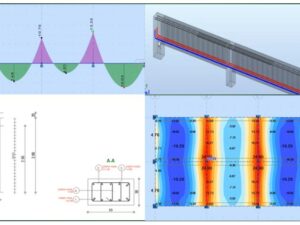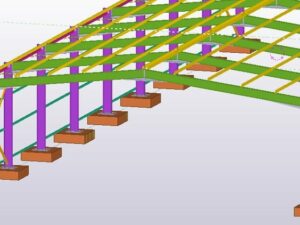BIM 101: ISO 19650 Demystified
- Description
- Curriculum
- FAQ
- Reviews

Welcome to “Mastering BIM and ISO 19650,” a comprehensive introduction course designed to equip you with essential skills and knowledge in the field of Building Information Modelling (BIM) and the ISO 19650 standards. This course is perfect for professionals looking to enhance their understanding of information management in construction and asset management.
Throughout the course, you’ll delve into the core principles of BIM, understanding its significance and application in modern construction projects. We’ll explore the ISO 19650 series, providing you with a detailed overview of these crucial standards and their role in the BIM framework. You will learn how these standards facilitate effective information management across the entire lifecycle of a built asset.
Key areas covered include the synergy between ISO 19650 and BIM, where you’ll discover how these standards enhance collaboration and efficiency among stakeholders. We’ll clarify industry jargon such as ‘Level of Model Definition,’ ‘Level of Detail,’ and ‘Level of Information,’ ensuring you have a solid grasp of these critical concepts. Additionally, you’ll gain insights into the multi-dimensional scope of BIM, extending beyond 3D modelling to include aspects like Digital Twins and the Common Data Environment (CDE).
The course also addresses the practical implications of BIM and ISO 19650 on your projects, from understanding the role of Information Management (IM) to learning about COBie, IFC, and the significance of OIRs, AIRs, EIRs, and PIRs. You’ll discover the importance of Asset Management within the BIM framework and explore whether BIM requires specific software.
By the end of this course, you’ll have a robust understanding of BIM and ISO 19650, empowering you to implement these standards effectively in your projects. Join us and take a significant step forward in your professional development.
-
100 - Welcome and Overview
As you begin the course, you might find the technical details and jargon of BIM and ISO 19650 standards overwhelming. Not sure where to start?
Our 3.5-hour core course plus many hours of additional content content is designed to help. You'll gain a clear understanding of BIM in plain English with minimal jargon.
Here’s what you can expect:
A FREE eBook, 'BIM Secrets'
3+ hours 'BIM 101: ISO 19650 Demystified' video tutorial
Curated extra content
Optional 1-hour coaching session
Digital badge and Professional Certification
Over 150 slides from the original classroom course
This self-paced, online course will empower you to confidently discuss BIM and the ISO 19650 standards. It’s perfect for grasping Information Management concepts, principles, processes, and best practices without the technical hassle.
Enjoy your learning journey anytime, anywhere, and transform your BIM knowledge!
-
201-00 - Intro to Section 01 - Introduction and Strategic Context to BIM
Intro to Section 01 - Introduction and Strategic Context to BIM
Welcome to Section 01, where we introduce the fundamentals and strategic context of BIM (Building Information Modelling). This section is designed to help you understand the basics of BIM and how it fits into the broader strategic landscape of information management.
In this section, you will learn:
The core principles of BIM and its significance in the construction and architecture industries.
The strategic advantages of adopting BIM, including improved collaboration, efficiency, and data management.
The key standards and guidelines, particularly the ISO 19650 series, that underpin effective BIM implementation.
How BIM aligns with organisational goals and the broader context of digital transformation in the built environment.
This foundational knowledge will equip you with the insights needed to appreciate the strategic value of BIM and set the stage for more in-depth learning in subsequent sections. Enjoy your journey into the world of BIM!
+ EXTRAS - Receive over 150 slides (in PDF format) from the original full-day classroom course (we will even answer questions about any of the slide content after the course, once you have reviewed them!).
As a thank you for booking onto 'BIM 101', we are pleased to share with you the complete slides from our full one-day version of this course. While this condensed version (that you are taking now) covers all the essential information you need to know, we wanted to ensure you have access to the same comprehensive content provided to participants of the classroom version.
Additionally, as an extra content, if you have any questions about the course content or anything in the slides that isn't clear, please email us, and we will promptly provide further explanation.
Download using Resources button
-
301-01 - Section 01 - Introduction and Strategic Context to BIM - PART 1
01-01 - Section 01: Introduction and Strategic Context to BIM - PART 1
In this section, we delve into why the ISO 19650 series and Building Information Modelling (BIM) are vital for the construction and built environment sectors.
We will cover:
Necessity of ISO 19650 and BIM: Understand why these standards are critical for enhancing efficiency, collaboration, and data management.
Drivers Behind Collaborative Work: Learn about the key factors that drive the need for collaborative approaches in construction projects.
Whole-Estate Approach: Discover the importance of a comprehensive, integrated approach to managing entire estates.
The 'Golden Thread' of Information: Explore the concept of maintaining a continuous, reliable thread of information throughout a project's lifecycle.
UK BIM Framework: Gain insights into the roles, scope, and components of the UK BIM Framework, which supports the implementation of BIM and the ISO 19650 series.
By the end of this section, you will have a clear understanding of the strategic importance and practical benefits of BIM and the ISO 19650 series, laying the groundwork for more in-depth learning in the subsequent sections.
BOUNS: eBook: You get a free eBook 'BIM Secrets - 21 Strategies to Drive BIM Adoption and Digital Transformation'. This book is authored by a BIM expert, who has been teaching and implementing Communication strategies and Change Management techniques for large-scale Information management (IM), Digital and BIM projects for many years.
Download using Resources bottom
-
401-01 - Section 01: Introduction and Strategic Context to BIM - PART 2
01-01 - Section 01: Introduction and Strategic Context to BIM - PART 2
In this section, we delve into why the ISO 19650 series and Building Information Modelling (BIM) are vital for the construction and built environment sectors.
We will cover:
Necessity of ISO 19650 and BIM: Understand why these standards are critical for enhancing efficiency, collaboration, and data management.
Drivers Behind Collaborative Work: Learn about the key factors that drive the need for collaborative approaches in construction projects.
Whole-Estate Approach: Discover the importance of a comprehensive, integrated approach to managing entire estates.
The 'Golden Thread' of Information: Explore the concept of maintaining a continuous, reliable thread of information throughout a project's lifecycle.
UK BIM Framework: Gain insights into the roles, scope, and components of the UK BIM Framework, which supports the implementation of BIM and the ISO 19650 series.
By the end of this section, you will have a clear understanding of the strategic importance and practical benefits of BIM and the ISO 19650 series, laying the groundwork for more in-depth learning in the subsequent sections.
-
501-02 - UK BIM Framework
The UK BIM Framework is an overarching approach that helps you to implement information management successfully into your business. The UK BIM Framework sets out the approach for implementing BIM in the UK using the framework for managing information provided by the ISO 19650 series.
What does the UK BIM Framework Solution Pack cover?
All of the core enabling BIM standards are made available in one Solution Pack which includes:
1. ISO 19650 Series
ISO 19650-1 - Outlines the concepts and principles and provides recommendations on how to manage building and asset information.
ISO 19650-2 - Provides information management requirements in the delivery phase of assets.
ISO 19650-3 - Provides information management requirements for the operational phase of the assets.
ISO 19650-4 - Complements Parts 1, 2, 3 and 5 by setting out an explicit process, with criteria, for individual information exchanges.
ISO 19650-5 - Provides requirements for the security-minded management of sensitive information within building information modelling (BIM).
PD 19650-0 - Provides transitional guidance on moving to ISO 19650.
2. PAS 1192-6 - This PAS specifies requirements for the collaborative sharing of structured H&S information throughout the project and asset life cycles, supporting the development of structured H&S information for all construction projects progressively from the outset.
3. BS 8536 - This British Standard promotes the smooth delivery and operation of built assets throughout their lifecycle by maximizing the value that can be derived from information and data.
Who is the UK BIM Framework Solution Pack for?
Those involved in the procurement, design, operations, maintenance, management, construction and/or commissioning of assets.
For owners and operators of assets of all sizes and levels of complexity from individual buildings and portfolios of buildings (government and commercial) to infrastructure networks (rail, road etc), and pieces of infrastructure (bridges, flood prevention etc).
Why should you use this UK BIM Framework Solution Pack?
The Construction Playbook was created to ensure that we change our approach to delivery and asset operation. It recommends using the UK BIM Framework to align with the correct BIM standards as well as having the right tools and guidance to make this a reality.
The UK BIM Framework outlines concepts and principles for information management at a stage of maturity described as “building information modelling (BIM) according to ISO 19650”.
It also provides recommendations for a framework to manage information including exchanging, recording, versioning and organizing for all actors.
It applies to the whole life cycle of an asset, including strategy, brief, concept, definition, design, builds and commission, handover and close-out, and operation and end of life.
The use of this Solution Pack will help remove barriers to collaborative working and competitive tendering across borders and increase opportunities. As well, the production and use of asset and project information models can also reduce risks and costs.
-
602-00 - Intro to Section 02 - BIM at Scale
Intro to Section 02 - BIM at Scale
-
702-01 - BIM at Scale
01-01 - Section 01: Introduction and Strategic Context to BIM
In this section, we delve into the impact of the UK BIM Framework on your organisation and supply chain.
We will cover:
Impact on Organisation and Supply Chain: Understand how the UK BIM Framework affects your business operations and the broader supply chain.
Business Process Review: Explore the potential for reviewing and improving your business processes through BIM implementation.
Competence Assessment: Learn about the importance of assessing and developing competence within your organisation to effectively utilise BIM.
Technology and Interoperability: Examine the technological aspects and the importance of interoperability in the successful implementation of BIM.
By the end of this section, you will have a comprehensive understanding of how the UK BIM Framework can transform your organisation, enhance supply chain collaboration, and improve overall efficiency and effectiveness.
----
Measuring the benefits of BIM
Measuring the benefits of BIM and the ISO 19650 series is a complex task. This section highlights some valuable documents developed in the UK to assist in this endeavour. Funded by the UK Government, these resources are shared here for public use and are divided into four parts.
The "PwC Summary Guidance to BIM Benefits Measurement" is part of a collection of reports aimed at assessing the impact of Level 2 BIM in the UK. This guidance is particularly beneficial for organisations implementing the ISO 19650 series, offering a systematic approach to measuring BIM benefits across asset planning, delivery, and operation phases.
The key documents included are:
Summary Guidance to BIM Benefits Measurement (BMM): Outlines the principles and rationale behind the measurement methodology, providing a framework to define potential benefits from the start of a project.
PwC Introductory Note to BIM Benefits Measurement: Offers an introductory context and underscores the importance of measuring BIM benefits.
PwC Benefits Methodology: Provides detailed methodologies for assessing BIM benefits, including various metrics and measurement models.
PwC Application Report: Illustrates practical examples and tests the application of the BMM on real projects, demonstrating how the methodology can be effectively implemented.
These documents are essential resources for organisations aiming to align their BIM practices with ISO 19650 standards and optimise the value derived from BIM implementation.
Download using Resources button
-
803-00 - Intro to Section 03 - Essentials of Information Management
03-01 - Intro to Section 03 - Essentials of Information Management
-
903-01- Section 03 - Essentials of Information Management
This section explains the concepts and principles of information management and outlines the various types of information requirements such as Organisational Information Requirements (OIRs), Asset Information Requirements (AIRs), Project Information Requirements (PIRs), and Exchange Information Requirements (EIRs). It also addresses the level of information need and the resources that support information delivery planning.
-
1003-02 - Section 03 - Level of Information Need
Here, you'll learn about level of information need.
Here, you'll learn about the level of information need as it relates to ISO 19650. This standard, which manages information over the life cycle of a built asset using building information modelling (BIM), distinguishes between the Level of Information (LoI) and the Level of Detail (LoD). LoI pertains to the richness and completeness of the information, ensuring all necessary data and documentation are included. LoD, however, focuses on the granularity and precision of the information content, such as geometrical data and attributes. Together, they ensure stakeholders have accurate, detailed, and comprehensive information throughout the project's life cycle.
-
1104-00 - Intro to Section 04 - Understanding Digital Information Exchange
Intro to Section 04 - Understanding Digital Information Exchange
-
1204-01 - Section 04 - Understanding Digital Information Exchange
Here, you'll learn about the principles of organisation and digitisation, how information delivery planning occurs between teams and the process and value of information exchange through projects and across the asset life cycle.
Download a this information (below), with links, as a PDF. Go to the Resources button.
Data Exchange Schemas & Classifications
· >buildingSMART International: Mission: To create & maintain open & reliable digital standards for the built environment & promote their global adoption.
· >Industry Foundation Classes (IFC): IFC is a standardised digital format used within the built asset industry. As an open international standard, specifically ISO 16739-1:2018, IFC supports interoperability and facilitates the sharing of information across different software applications, hardware devices, and interfaces. This standard plays a critical role in enhancing collaboration and cooperation by breaking down informational silos across various stakeholders in the industry, regardless of the technology tools they employ. Adopted globally, IFC enables improved communication and project management throughout the lifecycle of a building or infrastructure project.
· >COBie - US: The Construction to Operations Building information exchange (COBie) specification provides a standard organization of data used to manage and maintain facility assets. It is a combined set of all space, product, and equipment schedules found on associated design drawings as well as a compilation of as-built, operations & maintenance (O&M), and commissioning information captured during construction.
· >COBie - UK: Guide for COBie as part of the UK BIM Framework.
· >Uniclass 2015: It adheres to ISO 12006-2 standards and is the UK implementation of this standard. Uniclass 2015 encompasses all industry sectors, broadening the scope beyond previous iterations to enable uniform classification across buildings, engineering, landscape, and infrastructure. It adheres to ISO 12006-2 standards.Uniclass 2015 encompasses all industry sectors, broadening the scope beyond previous iterations to enable uniform classification across buildings, engineering, landscape, and infrastructure.
· >Omniclass: The OmniClass Construction Classification System, often referred to as OmniClass or OCCS, serves as a system for categorising and accessing construction industry information. It functions as the North American counterpart to Uniclass 2015. OmniClass adheres to ISO 12006-2 and is the North American implementation of this standard.
Download a this information, with links, as a PDF. Go to the Resources button.
-
1305-00 - Intro to Section 05 - Contractual and Legal Essentials of BIM
Intro to Section 05 - Contractual and Legal Essentials of BIM
-
1405-01 - Section 05 - Contractual and Legal Essentials of BIM
This segment discusses the necessary contractual interventions, the legal and commercial implications for your organisation and supply chain, the role of an Information Protocol, and issues of ownership and intellectual property. It also covers the security risks and measures that need to be in place.
Contractual Considerations - NEC4 and X10
NEC4, or the New Engineering Contract 4th edition, offers a framework for project management and procurement that facilitates collaboration and clear processes. The introduction of secondary Option X10 within NEC4 aligns with the requirements of ISO 19650, a series of standards that govern the organization and digitization of information about buildings and civil engineering works, including BIM (Building Information Modelling).
Option X10 is specifically tailored for managing and integrating Building Information Modelling (BIM) within NEC4 contracts. It provides for the creation or modification of an Information Model, which is crucial under the ISO 19650 series for managing information throughout the whole life cycle of a building or infrastructure asset.
The integration of NEC4 initially with the Construction Industry Council (CIC) BIM Protocol, now and with the Information Protocol which replaced it, particularly through secondary Option X10, is outlined in the NEC Practice Note 2 (April 2018). This practice note guides users on incorporating the Information Protocol (referred to as the 'CIC BIM Protocol' in the guide due to when it was produced) as the Information Model Requirements in the Scope of an NEC4 contract. It suggests specific terminology adjustments and scope entries to ensure alignment between the protocol and the contractual framework, thereby avoiding conflicts.
By using Option X10 and integrating the Information Protocol (formerly the CIC BIM Protocol), NEC4 contracts can effectively address and implement the information management requirements of the ISO 19650 series. This includes defining roles, responsibilities, and processes for information management, ensuring compliance with the standards and enhancing the overall efficiency and clarity in project delivery. The Information Protocol complements these efforts by providing detailed mechanisms and provisions to further refine the Information Model Requirements, contributing to a comprehensive approach to BIM within the ISO 19650 framework.
Find downloads in the Resources button
-
1506-00 - Intro to Section 06 - Common Data Environment Basics
Intro to Section 06 - Common Data Environment Basics
This section focuses on the requirements for a Common Data Environment (CDE), the status control of information containers, and the technical, technology, and interoperability requirements for successful data exchange.
-
1606-01 - Section 06 - Common Data Environment Basics
This section focuses on the requirements for a Common Data Environment (CDE), the status control of information containers, and the technical, technology, and interoperability requirements for successful data exchange.
-
1707-01 - Section 07 - Digital Twins: Beyond BIM
In this last section offers an overview of emerging technologies. It delves into the roles and impacts of data, digital approaches, and Digital Twins. Examining their applications and significance on ISO 19650, Information Management and BIM. Additionally, it provides insights into boarder future trends and technological advancements in AEC and Asset Management.
Go to the Resources button to download an abundance of Digital Twin and Infrastructure resources. Many of these are sourced from the UK Government and are publicly available.
-
1807-00 - Intro to Section 07 - Digital Twins: Beyond BIM
In this last section offers an overview of emerging technologies. It delves into the roles and impacts of data, digital approaches, and Digital Twins. Examining their applications and significance on ISO 19650, Information Management and BIM. Additionally, it provides insights into boarder future trends and technological advancements in AEC and Asset Management.
-
1907-02 - Congratulations - Course Completed!






Social Network